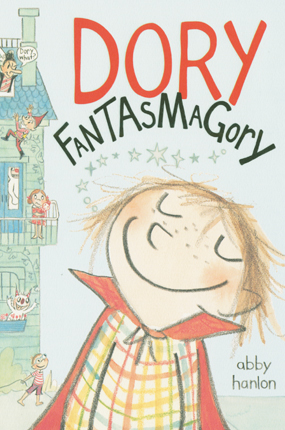| Dory Fantasmagory (Dory Fantasmagory) Author: Hanlon, Abby | ||
| Price: $22.58 | ||
Summary:
Dory, the youngest in her family, is a girl with a very active imagination, and she spends the summer playing with her imaginary friend, pretending to be a dog, battling monsters, and generally driving her family nuts.
| Accelerated Reader Information: Interest Level: LG Reading Level: 3.20 Points: 1.0 Quiz: 169512 | Reading Counts Information: Interest Level: K-2 Reading Level: 3.20 Points: 4.0 Quiz: 64643 | |
Reviews:
Kirkus Reviews (+) (09/01/14)
School Library Journal (+) (11/01/14)
The Bulletin of the Center for Children's Books (+) (02/15)
Full Text Reviews:
School Library Journal - 11/01/2014 Gr 1–3—Six-year-old Dory, known as Rascal to her family, wants more than anything to be included in her older siblings's fun, but her endless questions and make-believe monsters drive them crazy. When Violet and Luke tell Dory a bedtime story about the evil Mrs. Gobble Grackle, who steals baby girls, they unintentionally feed her already overactive imagination. Dory and her imaginary friend, Mary (who resembles Maurice Sendak's Max), are always on the lookout for monsters, and they thwart Mrs. Gobble Grackle's attempts to kidnap her with banana peels and sleep-inducing darts. When Dory pretends to be the dog her brother has always wanted, she convinces Mrs. G that she isn't the baby to kidnap and sabotages a trip to the doctor's office. Hanlon effectively uses many childlike pencil drawings and word balloons interspersed with a good mix of short and long sentences in brief, episodic chapters full of Dory's hilarious adventures. New vocabulary words are used in context within familiar settings and situations for the audience, creating a successful transitional book for new readers ready for longer stories. Dory ultimately finds a way to prove her bravery to her brother and sister, and readers will laugh at her entertaining antics.—Kristine M. Casper, Huntington Public Library, NY - Copyright 2014 Publishers Weekly, Library Journal and/or School Library Journal used with permission.
Bulletin for the Center... - 02/01/2015 To say that six-year-old Dory is imaginative is an understatement, but her older siblings, Luke and Violet, don’t appreciate her inventiveness. When Violet threatens Dory with a tale of a sharp-toothed robber named Mrs. Gobble Gracker who will be after Dory if she keeps acting like such a “baby,” the fib completely backfires as Dory is intrigued by the imaginary villainess: “Is she sneaky? Will I have to battle her? Does she wear a long black cape? Is it made out of fur? Is it real fur or fake fur?” Dory’s willingness to rescue a bouncy ball from the toilet proves her mettle to her siblings, though, and she finally gets to revel in some dramatic group play with them. Dory’s palpable longing to be part of her siblings’ activities adds just the right amount of heart-wrench to the story, and the family dynamics are humorously true-to-life. Eye-rolling older sibs will perhaps sympathize more with Luke and Violet, but most kids will be greatly amused by Dory’s comic escapades. The numerous and highly expressive monochromatic illustrations in childlike pencil style move easily from illustration to carrying the story, complete with speech bubbles. Fans of Ramona the Pest (BCCB 6/68) will particularly love this, and adults looking for a rib-tickling readaloud selection will find Dory fills the bill. JH - Copyright 2015 The Board of Trustees of the University of Illinois.



